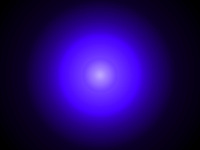Blue Light at Night Morning Delight

Do you ever see that episode of the original Star Trek in which Spock is accidentally – and temporarily – blinded when he is exposed to ultra-bright light to drive out a parasite? For people who like to know such things, it was episode 29, entitled Operation: Annihilate!
In the end it turns out that he only needed to have been exposed to one invisible wavelength of light. Naturally enough, being Star Trek it all comes out all right in the end.
I was reminded of this as I examined some extraordinarily important recent research from Thomas Jefferson University in Philadelphia. We have known for a long time that light is an effective treatment for seasonal affective disorder (SAD). However, until now, nobody has been able to determine the best wavelength to use. This new research found that the most effective wavelength was blue. It is thought that blue light therapy may help a great many more things than SAD.
SAD is one of a group of disorders involving our circadian rhythms. Many experts are currently trying to establish the relationship between SAD and another major disturbance of circadian rhythms: bipolar disorder. They are certainly not the same thing, but they are closely related to each other. Some other circadian rhythm disturbances that may respond to blue light are sleep disturbances, jet lag, sleepiness during shift work and spaceflight.
It has always been assumed that the brain’s major pacemaker – the suprachiasmatic nucleus (SCN) – only responded to bright light at a certain time of day. The SCN regulates the production of melatonin by the pineal gland. The fact that lower-intensity blue light is more effective than the most visible kinds of light is part of a body of evidence that there is a separate photoreceptor system within the human eye. The system that resets the body clock to the 24-hour day is different from the rods and cones used in regular vision.
In linked research by the same investigators, as well as a team from and Brigham and Women’s Hospital and Harvard Medical School in Boston, blue light was shown to directly reduce sleepiness. People exposed to blue light were able to sustain a high level of alertness during the night when people usually feel most sleepy. The results suggest that light may be a powerful countermeasure for the negative effects of fatigue for people who work at night.
There is more to this research: breast cancer is linked to fluctuations in human circadian rhythms, with higher rates in industrialized countries where there is a great deal of exposure to artificial light at night. It has been suggested that melatonin may be a link between artificial light and breast cancer. Blue light may perhaps mitigate some of the effects of light on suppressing melatonin.
There is another point to be made here. Many people teach techniques of being able to see the human aura. Many of the techniques of the “See the aura in 30 seconds” type, are no more than visual illusions. But there is another group of techniques that involves the use of peripheral vision to gradually become aware of the fields around people, animals and plants. By a strange “conincidence” the ancients identified the pineal gland with the “third eye.” Have the researchers inadvertently found a biological mechanism for seeing auras?
“Sleeplessness is a desert without vegetation or inhabitants.”
–Jessamyn West (American Writer, 1902-1984)







I was reading this to Hubby and laughed and recited the whole plot of the episode.
I’m not sure he caught the subtlties of the research however. I suppose that is why we balance each other out.
TTFN
Here is another blog deals with all kinds of sleep disorders.
http://aboutsleepdisorders.blogspot.com/
Thank you so much for tipping me off about that blog.
I have added it to my own “What I am reading section” and subscribed to it.
Kind regards,
RP